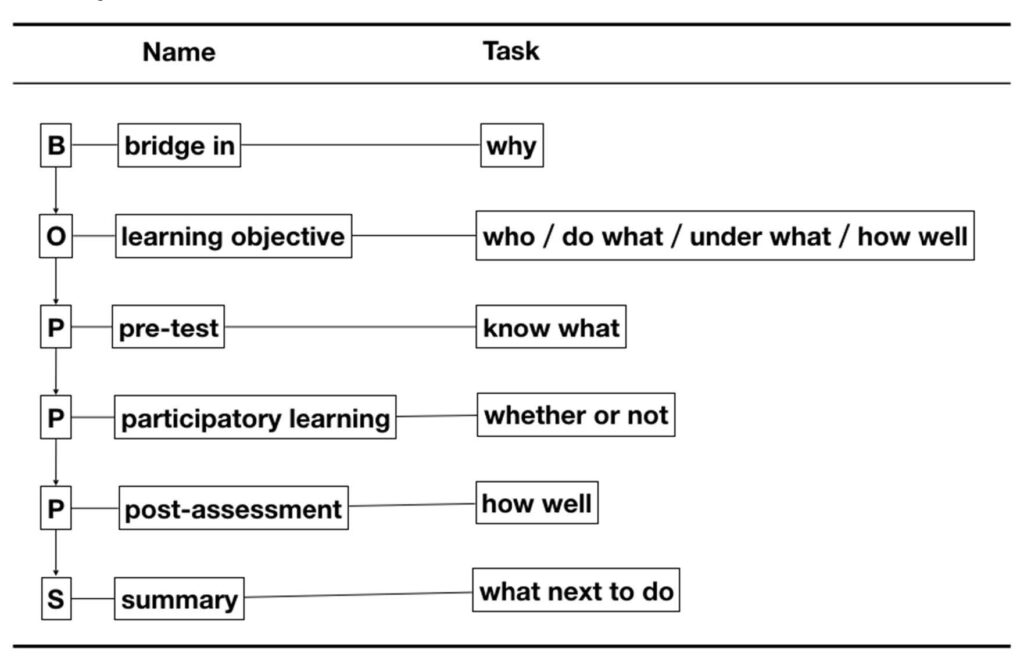By Huang Liangpeng, Lin Meiting, and Chen Xianwang
The teaching design concept of BOPPPS mode is to divide the classroom teaching into Bridge in, Objective, Preassessment, Participatory learning, Post-assessment and Summary six links (Figure 1), the following describes each link.

Bridge-in
The bridge-in is the first link in the BOPPPS teaching mode. The main purpose is to enable visual communication design students to understand the main content of course learning and stimulate students’ interest in learning. In the bridge-in stage, teachers need to focus on the design theory and value of the course, combined with design practice learning, to stimulate students’ interest through a story closely related to the course learning content or successful cases, and put the cases with learned theoretical knowledge in a coherent manner, and at the same time, questions related to the teaching theme are proposed, and the students are allowed to enter the self-learning process of the core practical teaching content.
Object
The object emphasizes the student-centered teaching model. The purpose of design theory teaching is to enable students to translate basic theoretical knowledge into design skills and innovative creative ability through theoretical study. Through design theory learning, it is possible to obtain correct analysis objects and propose reasonable design solutions ability. Therefore, the design theory teaching objectives need to be more specific and clear. The object of a design course should be only for one or a few methods. Teachers should repeatedly emphasize and clearly explain the specific content points that should be mastered in this practical study, such as the creative performance of the design, the appreciation of the relevant design and the corresponding design methods. Obviously, the clear teaching goal is conducive to teachers in combination with the design of students encounter specific confusion in practice, better design of the corresponding teaching strategies and continuous improvement of teaching methods.
Pre-assessment
After clarifying the teaching objectives, it is necessary to pre-evaluate or explore the knowledge background and knowledge of the students. The bottoming can be carried out through various methods such as questioning, quiz or discussion. The main purpose is to quickly and accurately grasp the knowledge base of the students and the understanding of the teaching content. The teacher adjusts the teaching arrangement in time according to the needs of the course objectives and the actual situation of the students. (Danping Cao, Xingyao Yin, 2016)By understanding the students’ familiarity with the practical teaching content in a variety of ways, teachers adjust the curriculum in time, and could arrange more cases for students to explain or discuss according to the unfamiliar knowledge points; on the other hand, students can further understand the key contents to be mastered of the practical course through the teacher’s pretest contents, which is benefit to clear purpose in the follow-up study process, and get better study results.
Participatory learning
Participatory learning is one of the other major links in the BOPPPS model. This stage is mainly through multiple forms of teacher-student interaction, repeated questions and answers, so that students can acquire new knowledge and master new skills in the interaction.
The main task of the teacher is to select the theme according to the goal of this teaching. After grouping the students, they will communicate with different groups and make basic plans for design through investigation, design and data reading. After each group completes the preliminary plan, each group of students will conduct detailed communication and report to discuss the design plan of the group. At this time, the teacher can raise questions according to the student’s report situation and guide the students to think further. The arrangement of this method is completely different from the previous design theory lesson, which avoids the traditional cramming mode of teaching, making the students become learning subject of the class. In the process of communication, students not only exercise their ability to think, express, and cooperate, but also deepen students’ understanding of the theory and their own unique understanding, so that knowledge can be more deeply impressed.
Post-assessment
The post-assessment is to test the students’ mastery and understanding of the classroom knowledge through a targeted evaluation method, and fully understand whether the students really learn the knowledge and ability and achieve the set teaching goals. Through the feedback of learning effects, further adjustments to subsequent teaching content and methods are guided. The teaching of visual communication design principle can be to ask questions or short paper writing, to the classroom content as the topic for students to analyze and answer, to supplement the students ‘ learning missing or weak knowledge points.The main purpose of this test is to let students truly understand the omissions and deficiencies in their learning. From the point of view of teachers, teachers can continuously correct and improve the teaching content and methods through post-assessment results, enhance the effectiveness of teaching, and strive to achieve the best teaching objectives.
Summary
The final summary is a summary of the content in class, which plays as a connecting link between the preceding and the following class. The student’s feedback on the mastery of the learning content, and the teacher also sorts out and summarizes the content of the teaching. Evaluation and feedback is the central link, can let teachers fully summarize the advantages and disadvantages in the teaching process, in order to improve the BOPPPS teaching model in the “Visual Communication design Principles” course of the application.
References
Cao danping and Yin xingyao (2016). Canadian BOPPPS teaching model and its implications for
higher education reform. Laboratory research and exploration, 35(02), 196-200+249.
Liangpeng, H., Meiting, L., & Xianwang, C. (2019). Research on teaching design based on BOPPPS mode: A case study of the course “Principles of Visual Communication Design”. IPO Conference Series: Materials Science and Engineering, 573(2019). 1-6. doi:10.1088/1757-899X/573/1/012054.
Content from this work may be used under the terms of the Creative Commons Attribution 3.0 licence. Any further distribution of this work must maintain attribution to the author(s) and the title of the work, journal citation and DOI.